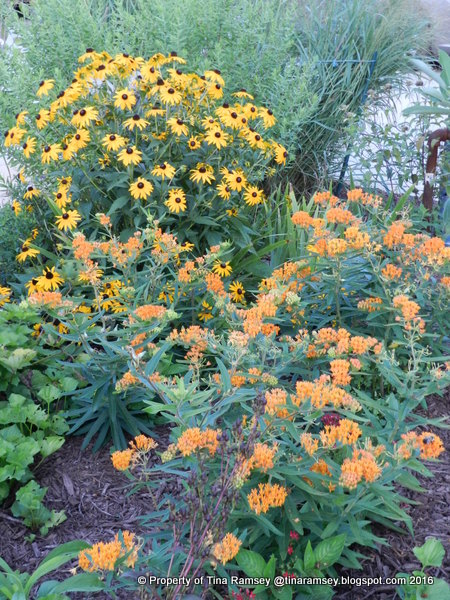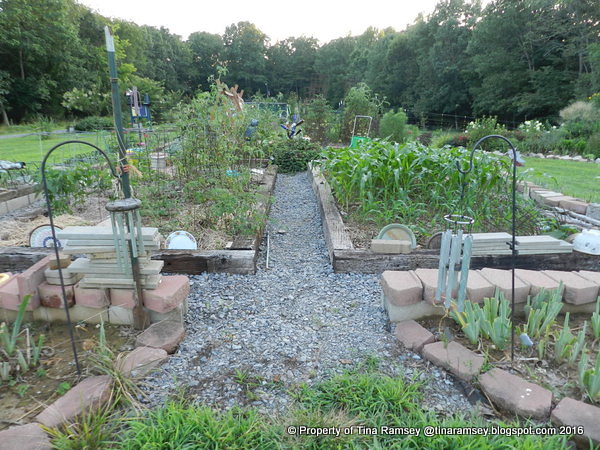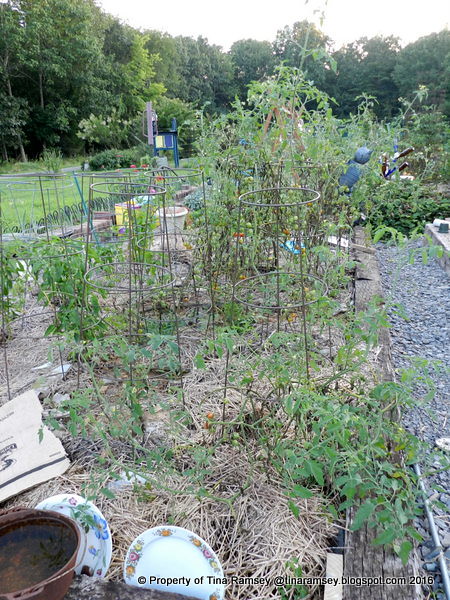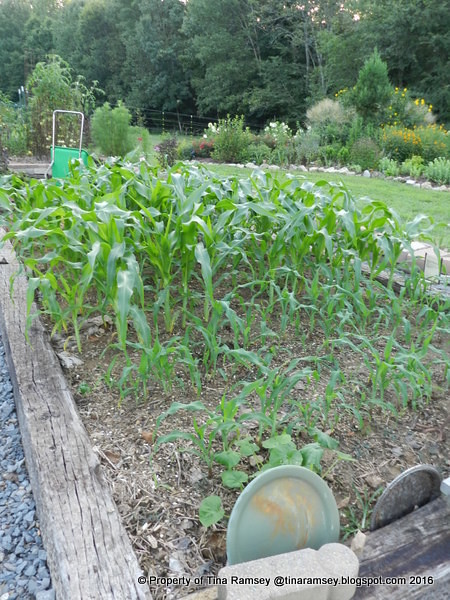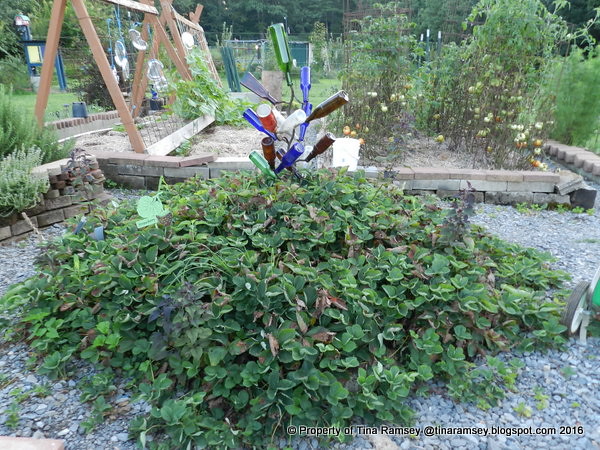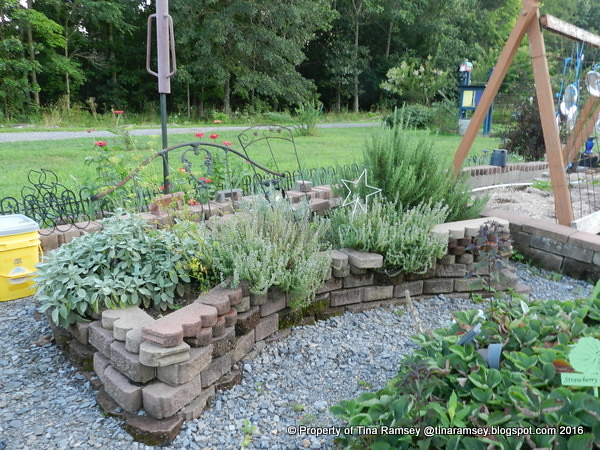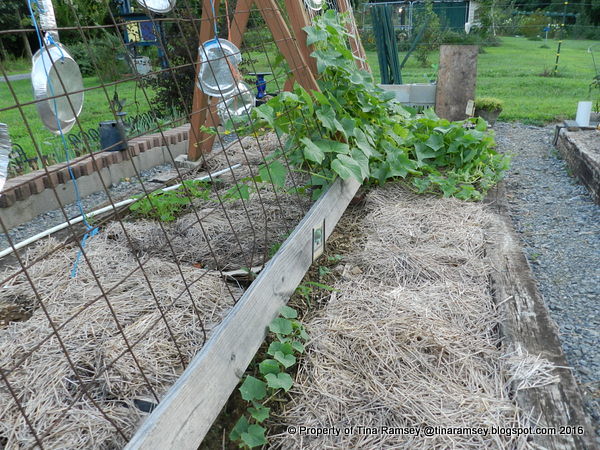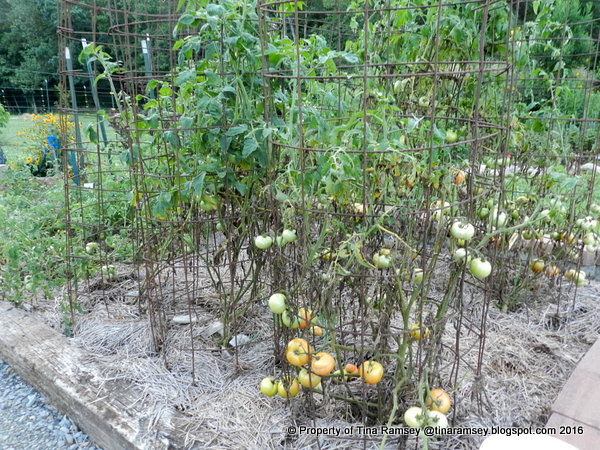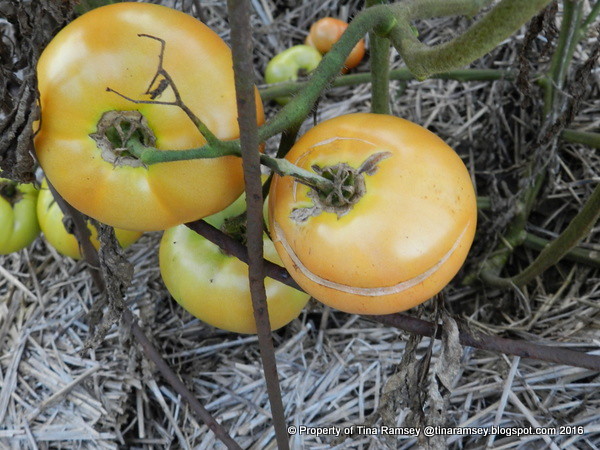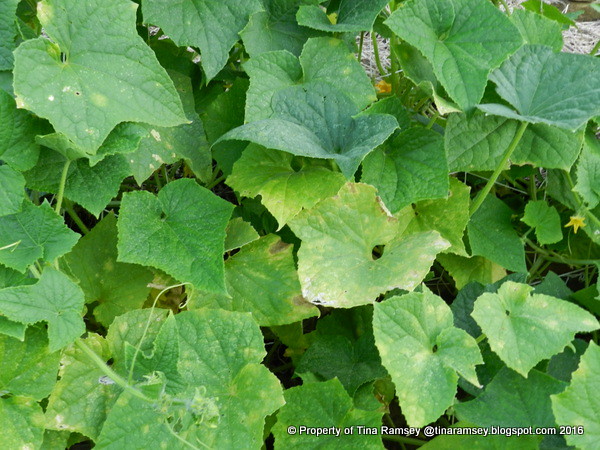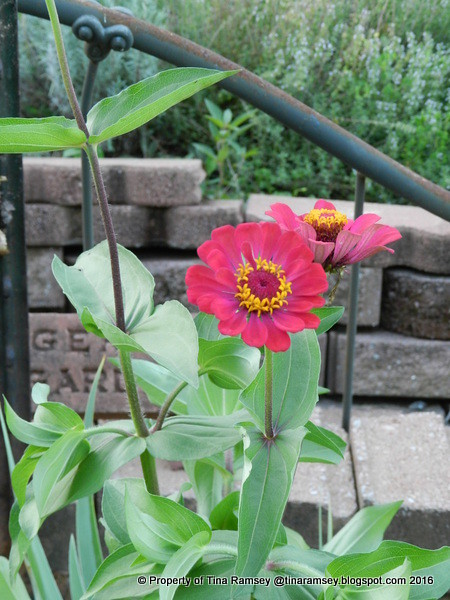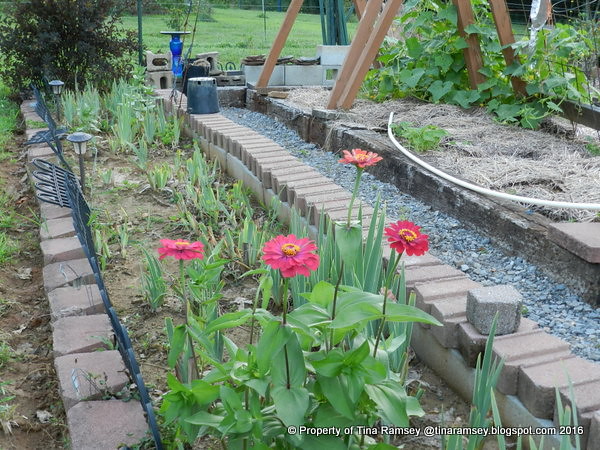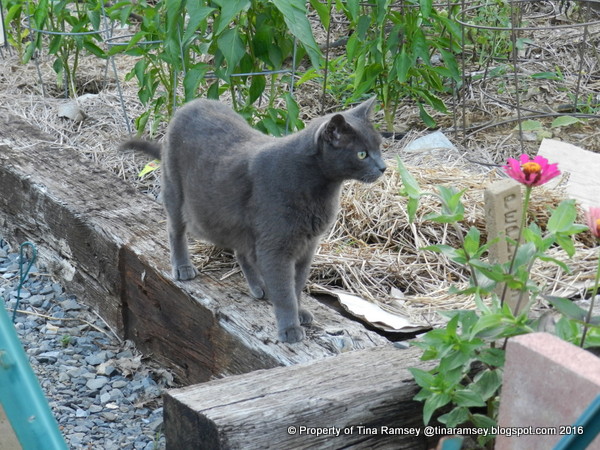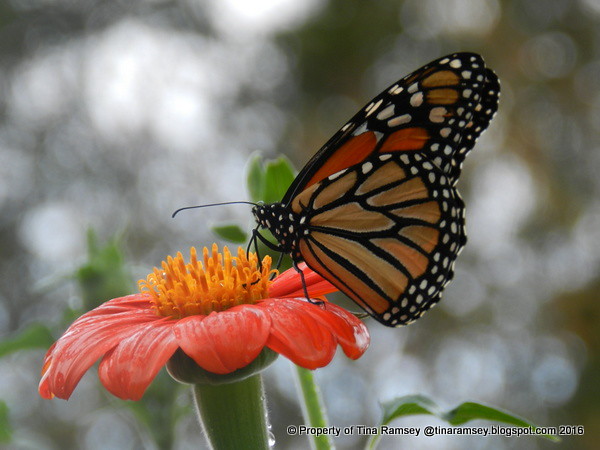 A recent walk around Tiger Way Gardens had me finding lots of neat fall colors. Above is a monarch sipping from a Mexican sunflower (Tithonia). Funny thing about Mexican sunflowers, I've never grown them before and don't really know where this one came from amongst the zinnias. I almost pulled it out but due to lazy weeding, it bloomed before it was doomed. That was a good thing! Monarchs love tithonias.
A recent walk around Tiger Way Gardens had me finding lots of neat fall colors. Above is a monarch sipping from a Mexican sunflower (Tithonia). Funny thing about Mexican sunflowers, I've never grown them before and don't really know where this one came from amongst the zinnias. I almost pulled it out but due to lazy weeding, it bloomed before it was doomed. That was a good thing! Monarchs love tithonias.
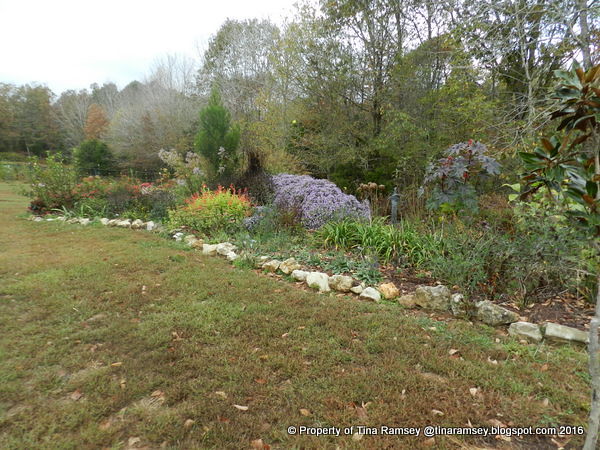 The front corner garden is outstanding in its fall glory. This garden never fails to please me. Except for the dastardly weeds (which thankfully you probably can't see too well from this angle).
The front corner garden is outstanding in its fall glory. This garden never fails to please me. Except for the dastardly weeds (which thankfully you probably can't see too well from this angle).
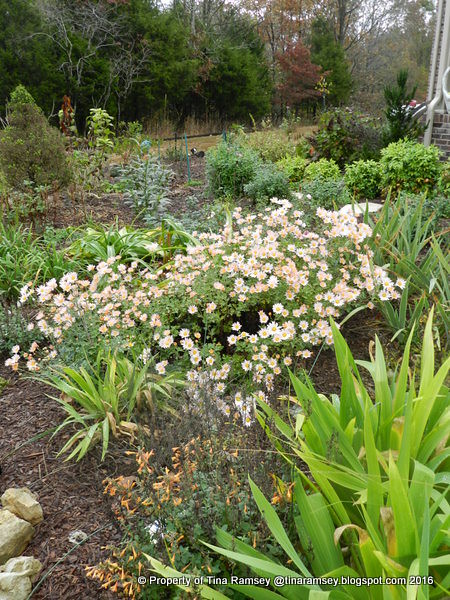 The Sheffies in the front foundation garden are putting on quite a show. Here they are paired with hyssop, spirea, and Japanese roof irises.
The Sheffies in the front foundation garden are putting on quite a show. Here they are paired with hyssop, spirea, and Japanese roof irises.
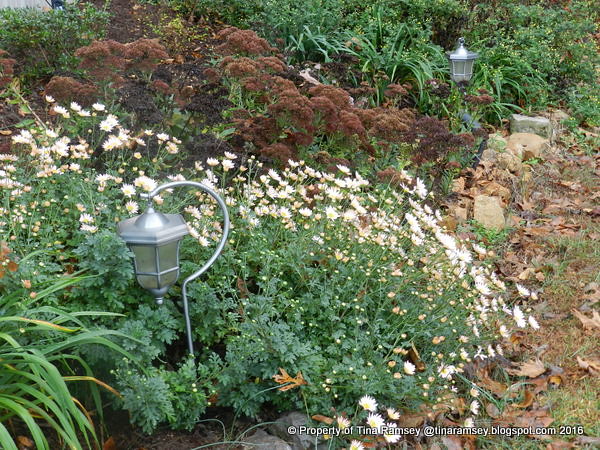 Another garden has a bunch of Sheffies. Here they are paired with daylilies, 'Autumn Joy' sedum, and tall yellow garden mums.
Another garden has a bunch of Sheffies. Here they are paired with daylilies, 'Autumn Joy' sedum, and tall yellow garden mums.
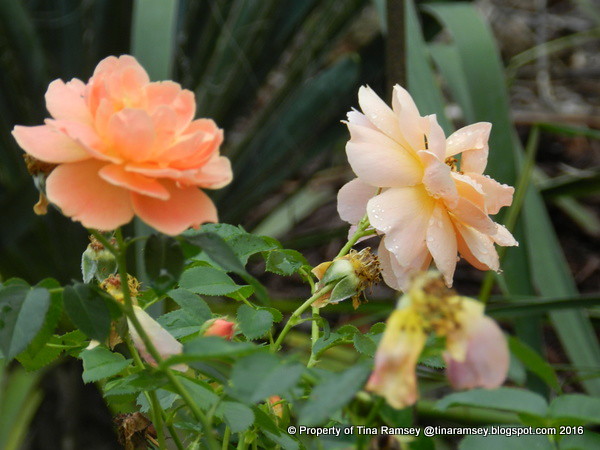 'At Last' rose is an AHmazing rose. It blooms and blooms, has a great rose scent, and does not get foliage diseases (at least in my garden this rainy summer).
'At Last' rose is an AHmazing rose. It blooms and blooms, has a great rose scent, and does not get foliage diseases (at least in my garden this rainy summer).
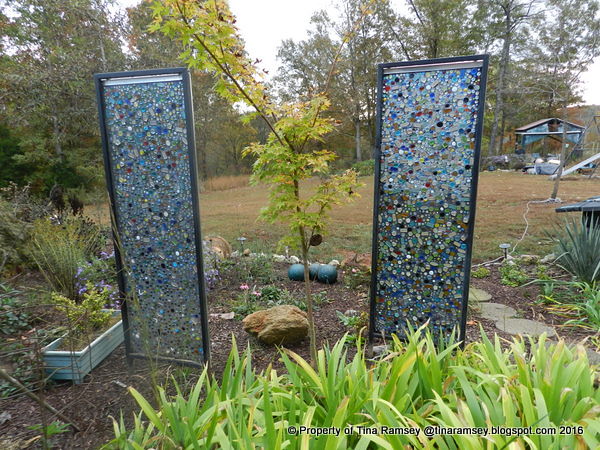 My beloved glass mosaics are finally in their new home. I am very happy they survived the move, the subsequent storage, and then reinstallation. Considering these have been in the garden since 2009 that is fantastic!!
My beloved glass mosaics are finally in their new home. I am very happy they survived the move, the subsequent storage, and then reinstallation. Considering these have been in the garden since 2009 that is fantastic!!
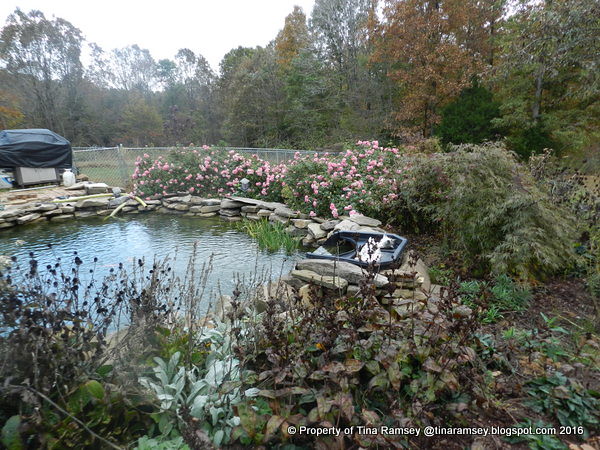 The koi pond with its surrounding pink garden is a highlight for me. All of the koi are active and eating well. We've not had a single issue with wildlife dining on the koi. Thank goodness!
The koi pond with its surrounding pink garden is a highlight for me. All of the koi are active and eating well. We've not had a single issue with wildlife dining on the koi. Thank goodness!
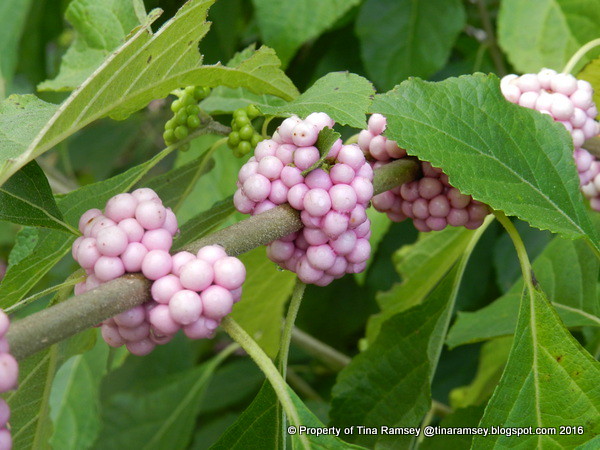 Beautyberry (Callicarpa bodinieri 'Profusion') is beginning to color up. This is a rather large shrub that continues to grow, flower, and fruit even with multiple prunings during the growing season. I like it a lot.
Beautyberry (Callicarpa bodinieri 'Profusion') is beginning to color up. This is a rather large shrub that continues to grow, flower, and fruit even with multiple prunings during the growing season. I like it a lot.
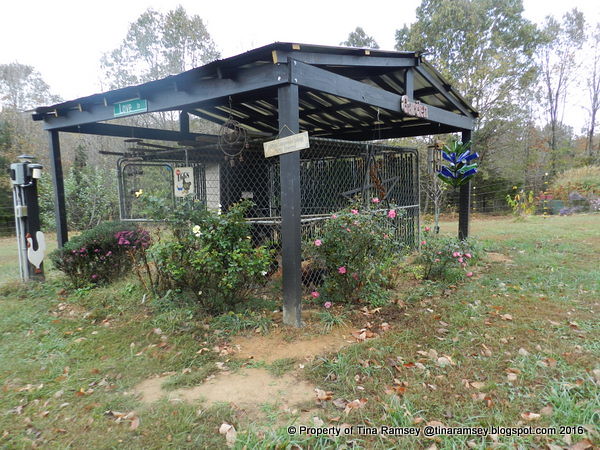 The chickens got a new roof over their run to keep them dry this winter. This was a long time coming project but it is mostly finished for now.
The chickens got a new roof over their run to keep them dry this winter. This was a long time coming project but it is mostly finished for now.
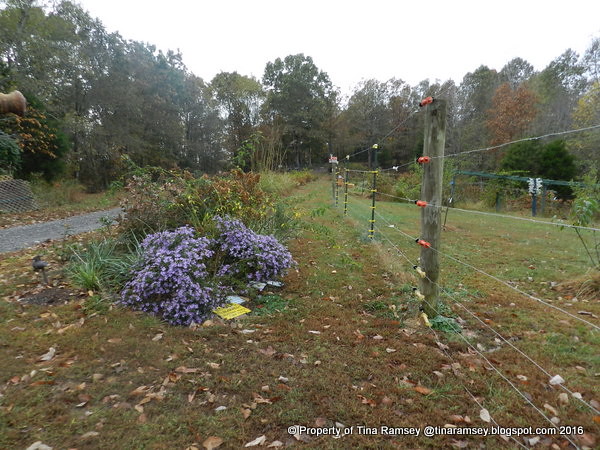 Looking down the driveway along the south side of the orchard we see asters in the butterfly garden and lots of PG hydrangeas and grasses. The leaves are beginning to fall in earnest as well.
Looking down the driveway along the south side of the orchard we see asters in the butterfly garden and lots of PG hydrangeas and grasses. The leaves are beginning to fall in earnest as well.
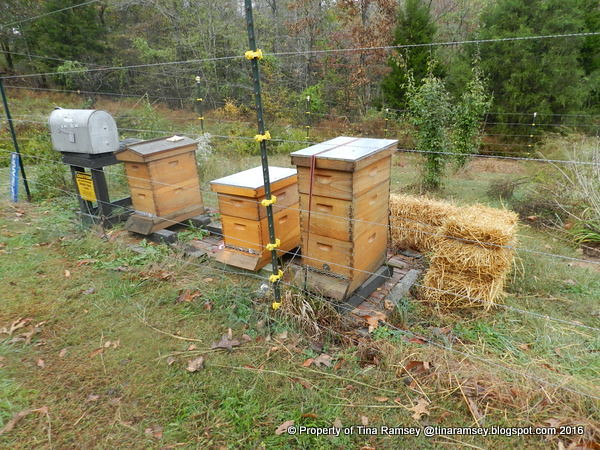 The beehives have had their mouseguards installed and I am in the process of hay baling the northwest side of the hives in order to block the cold north winds. I am most relieved to be mostly done with the bees until next spring.
The beehives have had their mouseguards installed and I am in the process of hay baling the northwest side of the hives in order to block the cold north winds. I am most relieved to be mostly done with the bees until next spring.
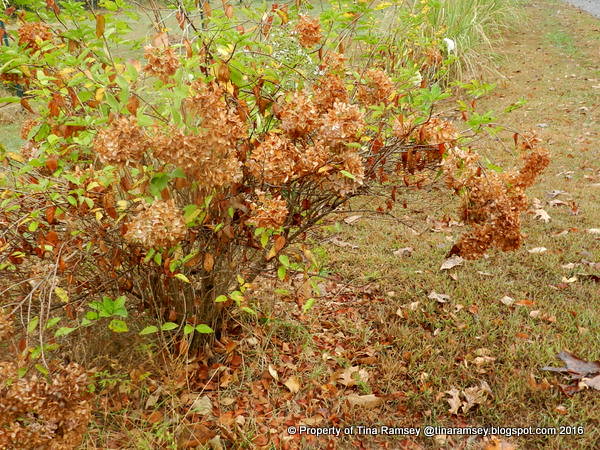 Some of these PG hydrangeas are still showing new blooms but most have faded to the brown flowers they'll keep all winter. I love these as much for their winter interest as for their bloom in the summer.
Some of these PG hydrangeas are still showing new blooms but most have faded to the brown flowers they'll keep all winter. I love these as much for their winter interest as for their bloom in the summer.
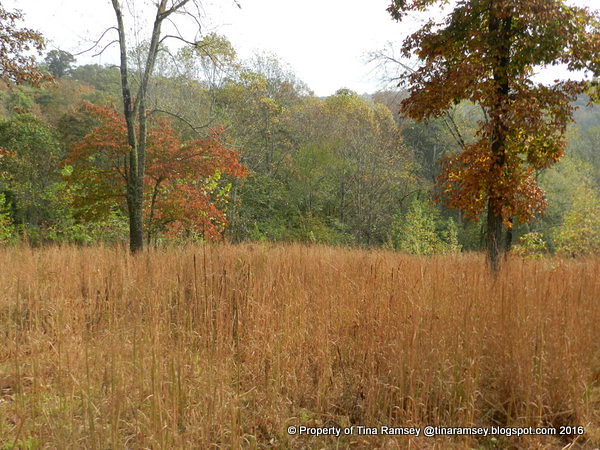 On the back 40 Wildflower Hill is doing its stuff. The broomsedge has turned brown and the trees are coloring up. We don't seem to get much fall color in Tennessee, especially when it has been dry, but some trees color up nicely. The short red tree is a native dogwood. These almost always have a lovely red fall color.
On the back 40 Wildflower Hill is doing its stuff. The broomsedge has turned brown and the trees are coloring up. We don't seem to get much fall color in Tennessee, especially when it has been dry, but some trees color up nicely. The short red tree is a native dogwood. These almost always have a lovely red fall color.
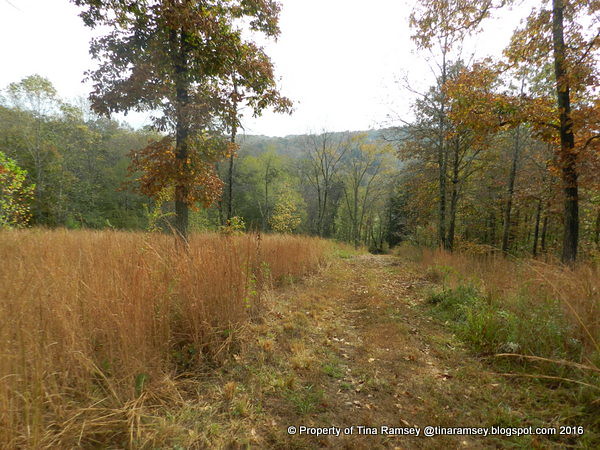 The hickories in the foreground turn a russet color. I mowed a path down the hill and oftentimes this path beckons me to travel onwards.
The hickories in the foreground turn a russet color. I mowed a path down the hill and oftentimes this path beckons me to travel onwards.
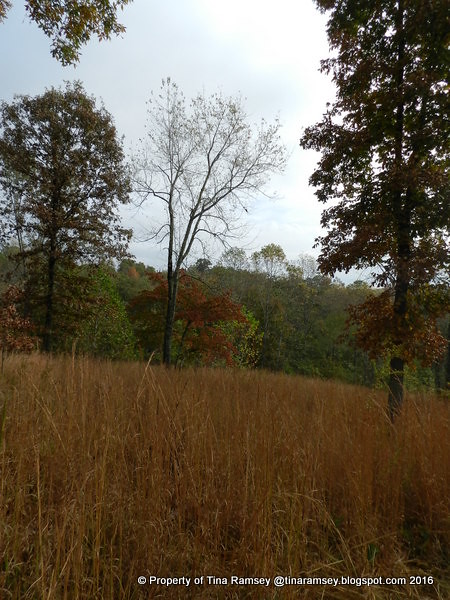 This is simply one of my favorite sights on the property.
This is simply one of my favorite sights on the property.
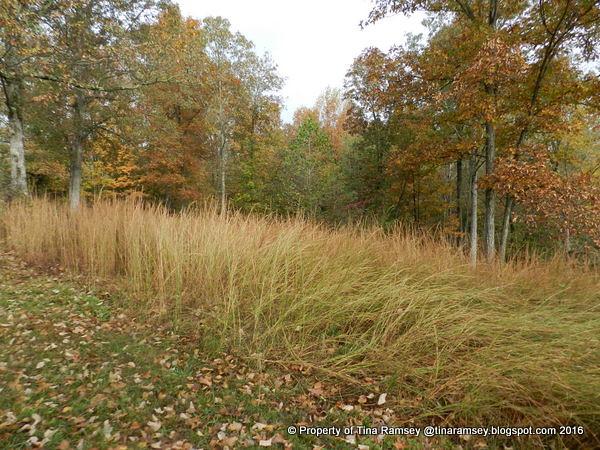 I mow the flat part of the crest of the hill and have planted numerous nut trees in this area.
I mow the flat part of the crest of the hill and have planted numerous nut trees in this area.
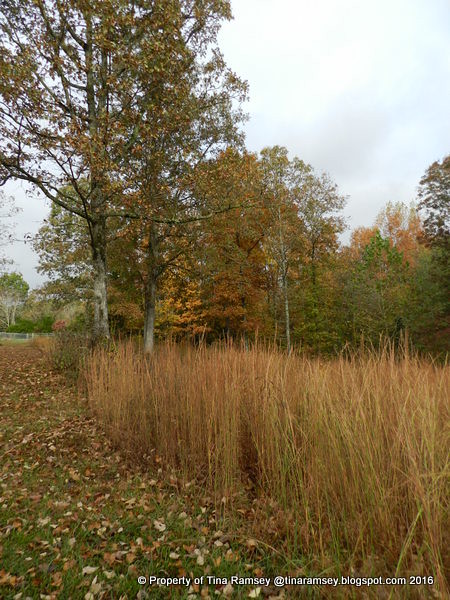 More of the russet hickory trees. Our forest is predominately Oak/hickory hardwoods and I try hard to maintain it thusly.
More of the russet hickory trees. Our forest is predominately Oak/hickory hardwoods and I try hard to maintain it thusly.
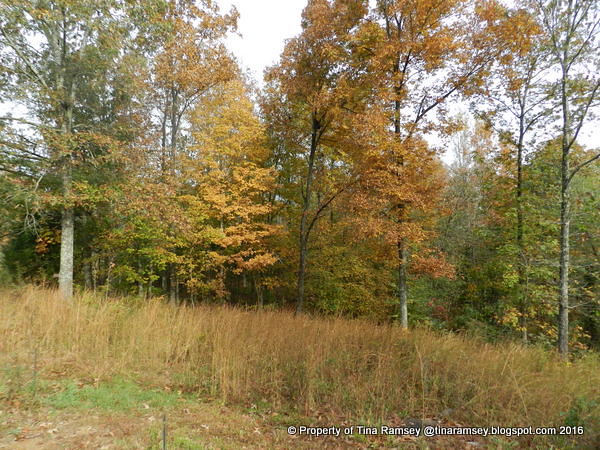 Some golds mix in with the russets.
Some golds mix in with the russets.
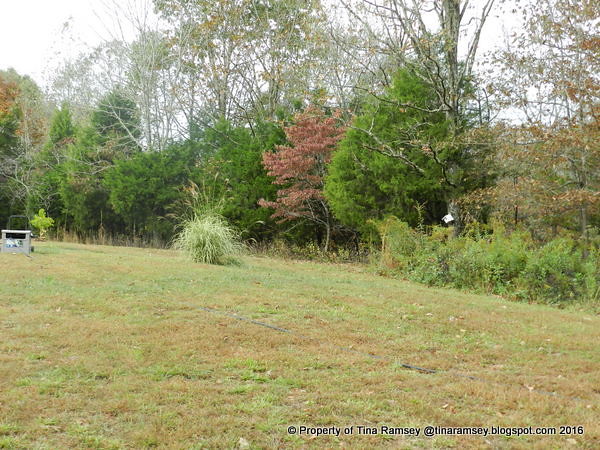 A dogwood and cedar stand mix well in this southern facing exposure.
A dogwood and cedar stand mix well in this southern facing exposure.
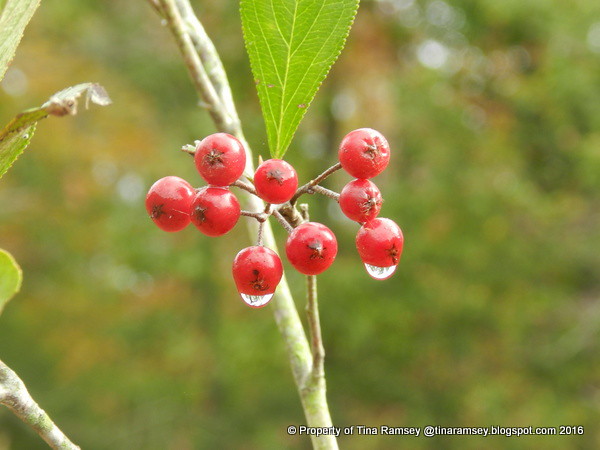 Aronia arbutifolia 'Brilliantissima', aka red chokeberry, is coloring up. These berries will persist all winter long as long as the wildlife does not find them.
Aronia arbutifolia 'Brilliantissima', aka red chokeberry, is coloring up. These berries will persist all winter long as long as the wildlife does not find them.
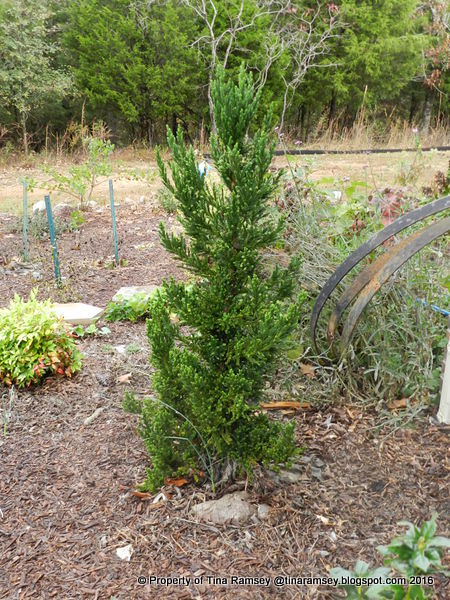 I finish back at the house in a foundation garden. This is one of four 'Black Dragon' (Cryptomeria japonica) and they are finally getting their beautiful shape. I purchased four of these as markdowns two years ago. 'Black Dragons' can be very expensive but are so beautiful I had been on the lookout for them. All four are planted along the foundation corners in the front of my home. They are actually growing fairly quickly and once mature will make lovely counterpoints to the house. Additionally, since they are evergreen they provide year round interest.....
I finish back at the house in a foundation garden. This is one of four 'Black Dragon' (Cryptomeria japonica) and they are finally getting their beautiful shape. I purchased four of these as markdowns two years ago. 'Black Dragons' can be very expensive but are so beautiful I had been on the lookout for them. All four are planted along the foundation corners in the front of my home. They are actually growing fairly quickly and once mature will make lovely counterpoints to the house. Additionally, since they are evergreen they provide year round interest.....
in the garden......
I don't post as much as I used to, but I am fairly active on my Facebook page found here. I find it so much easier to be in the spur of the moment to post interesting things on FB with my smartphone rather than on the blog. So if you like Coach in the Garden and would like to keep up with the plant happenings in Tiger Way Gardens please check out and like my professional page...in the garden.
Words and Photos Property of In the Garden Blog Team, In the Garden
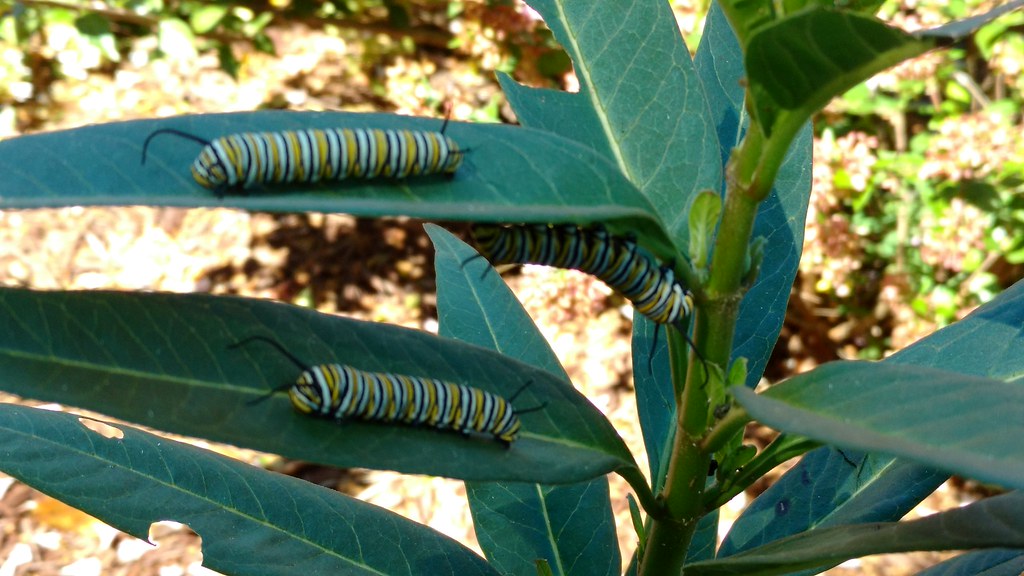 It is monarch haven here in Tiger Way Gardens and I have been enjoying all of the baby butterflies-in the form of caterpillars-tremendously. I thought I'd share a few with you all today. Above we have three monarch caterpillars munching on Asclepias tuberosa, aka butterflyweed. I started all of my butterflyweed from seeds in January 2016 via winter sowing. The plants have all been planted in the gardens and many are now blooming. Most all of the plants have monarch caterpillars feasting on them. Butterflyweed is easy to start from seed and I definitely recommend winter sowing for them.
It is monarch haven here in Tiger Way Gardens and I have been enjoying all of the baby butterflies-in the form of caterpillars-tremendously. I thought I'd share a few with you all today. Above we have three monarch caterpillars munching on Asclepias tuberosa, aka butterflyweed. I started all of my butterflyweed from seeds in January 2016 via winter sowing. The plants have all been planted in the gardens and many are now blooming. Most all of the plants have monarch caterpillars feasting on them. Butterflyweed is easy to start from seed and I definitely recommend winter sowing for them.
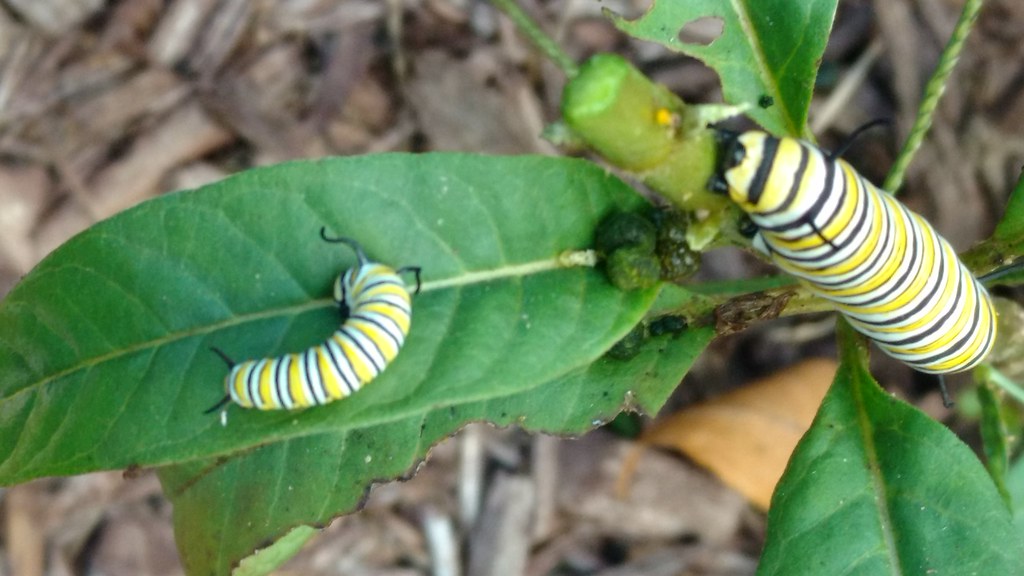
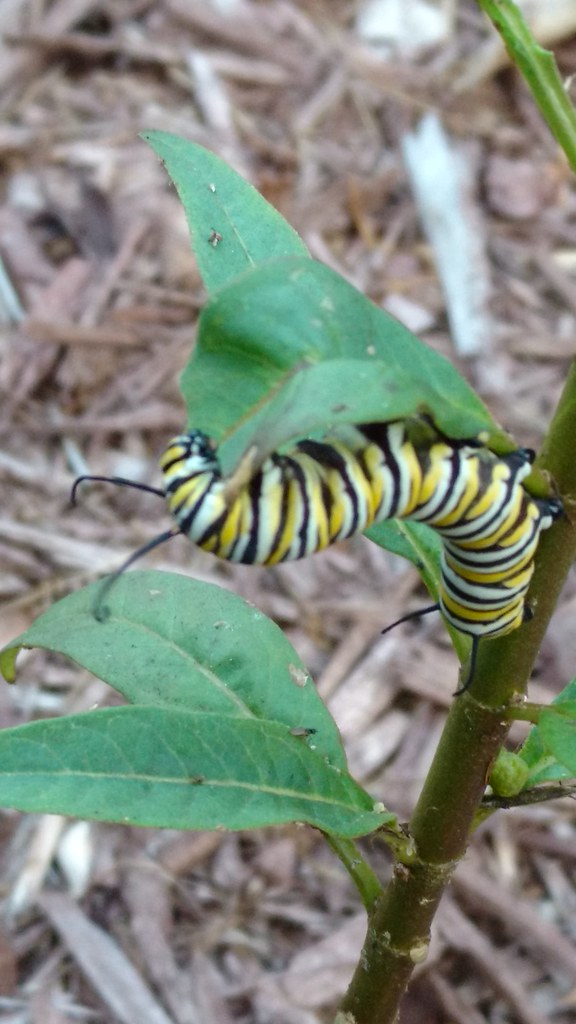 The pictures are not the very greatest because they were taken with my phone but it was all I had at the time.
The pictures are not the very greatest because they were taken with my phone but it was all I had at the time.
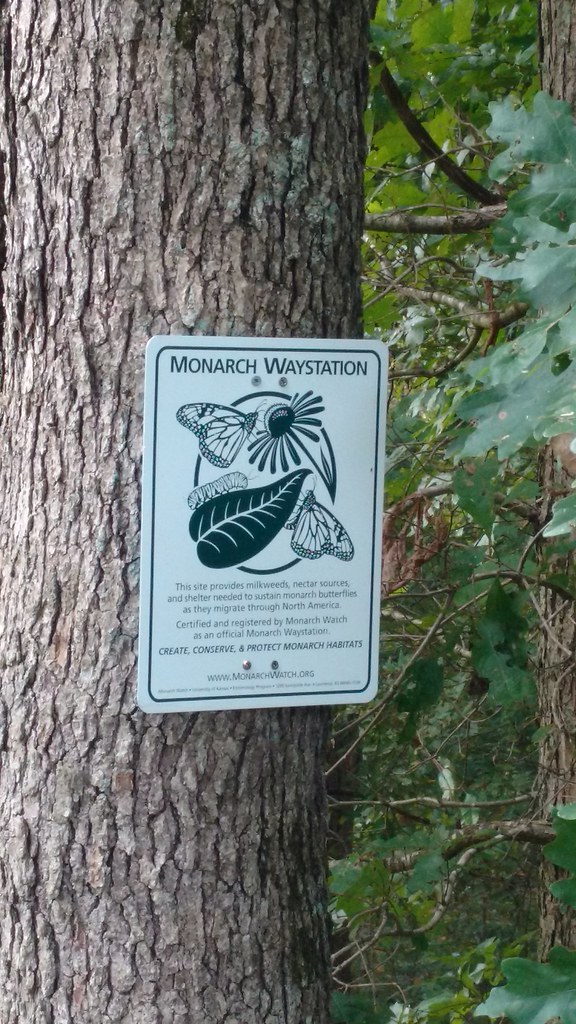 Last year I had my property certified as a monarch waystation and I'd say judging by all the monarchs flitting about laying their eggs here we have become a pretty good monarch waystation.This is not the first year I've had monarch caterpillars but the population has exploded over last year's population. All of the newly planted milkweeds have made quite a difference.
Last year I had my property certified as a monarch waystation and I'd say judging by all the monarchs flitting about laying their eggs here we have become a pretty good monarch waystation.This is not the first year I've had monarch caterpillars but the population has exploded over last year's population. All of the newly planted milkweeds have made quite a difference.
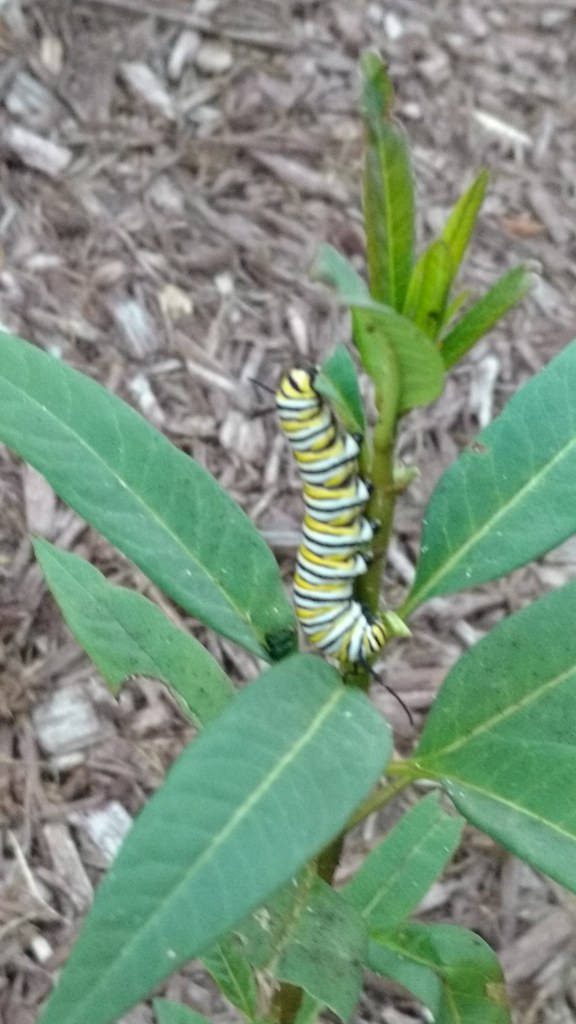 One monarch caterpillar can completely eat a butterfly host plant to the stem. All of the host plants for monarch are plants in the asclepias family. Things such as the above mentioned butterflyweed, swamp milkweed, whorled milkweed, showy milkweed, redring milkweed, common milkweed, and many more.
One monarch caterpillar can completely eat a butterfly host plant to the stem. All of the host plants for monarch are plants in the asclepias family. Things such as the above mentioned butterflyweed, swamp milkweed, whorled milkweed, showy milkweed, redring milkweed, common milkweed, and many more.
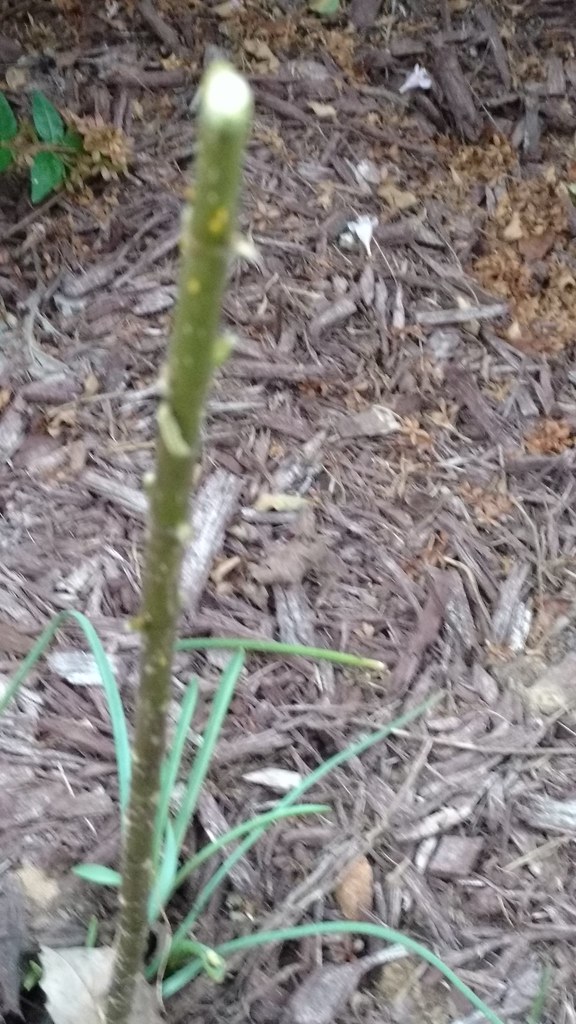 This stem above is all that remains of swamp milkweed and as you can see there are now NO leaves on it. I ordered 100 swamp milkweed plants and 100 whorled milkweed plants from Monarch Watch last summer. I did not receive any plants until this summer--but they did finally come. I have planted out all of the swamp milkweed but not all of the whorled milkweed. Two hundred plants are a LOT to plant out on the property so it is a slow process for me. Hopefully we'll get some rain soon so I can finish planting all of the milkweed. This milkweed will recover and I do not worry that it is leafless.
I have tried to restore our property to a fairly natural habitat which includes wildlife areas that involve not only flowers, but trees and watering and sheltering spots for pollinators as well as wildlife. The milkweeds were an addition for the monarchs. I was absolutely delighted to see monarchs not only on my butterflyweed but also on the swamp milkweed. All of these plants are pesticide free and are growing in gardens. I really haven't checked the wild milkweed yet for caterpillars but hope they are playing host as well as the cultivated plants I grow.
This stem above is all that remains of swamp milkweed and as you can see there are now NO leaves on it. I ordered 100 swamp milkweed plants and 100 whorled milkweed plants from Monarch Watch last summer. I did not receive any plants until this summer--but they did finally come. I have planted out all of the swamp milkweed but not all of the whorled milkweed. Two hundred plants are a LOT to plant out on the property so it is a slow process for me. Hopefully we'll get some rain soon so I can finish planting all of the milkweed. This milkweed will recover and I do not worry that it is leafless.
I have tried to restore our property to a fairly natural habitat which includes wildlife areas that involve not only flowers, but trees and watering and sheltering spots for pollinators as well as wildlife. The milkweeds were an addition for the monarchs. I was absolutely delighted to see monarchs not only on my butterflyweed but also on the swamp milkweed. All of these plants are pesticide free and are growing in gardens. I really haven't checked the wild milkweed yet for caterpillars but hope they are playing host as well as the cultivated plants I grow.
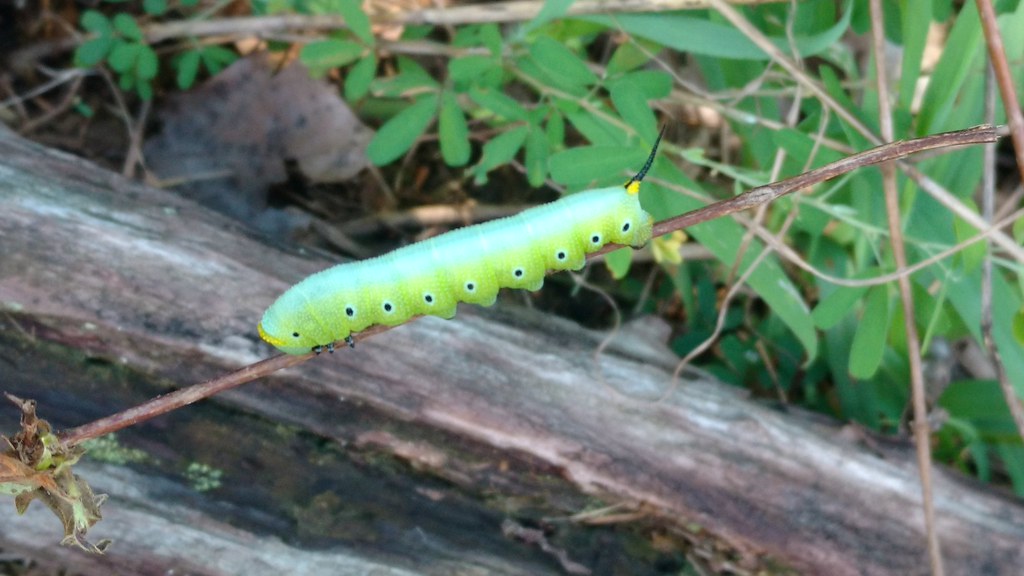 Talking about plants being eaten to the stem this here is what I believe to be a snowberry clearwing moth caterpillar. I don't have any snowberry plants in my garden but these caterpillars will also much on honeysuckle (Lonicera) and bush honeysuckle (Diervilla) and I do have both of them on the property. This caterpillar was most likely munching a good stand of lonicera nearby. Many people see these 'hornworms' and automatically kill them. I think that is so sad. I try very hard not to kill most things. I make exceptions for ticks and known pests. Not all 'hornworms' are bad and even if they do eat plants the plants will grow back. I promise you. I've had several batches of monarch caterpillars this year and just when I thought the butterflyweed was dead and gone it comes back! The relationship between caterpillars and their host plants must be a reciprocal one or both might die. For sure if a caterpillar killed every host plant it ate, then there would be no more host plant foods and no more caterpillars. So please, do not be alarmed when your plants disappear. They will rebound. Even tomato plants with hornworms on them will rebound depending on the time of the season. If you must 'save' your plant from hornworms, please move the caterpillar to a more appropriate plant or, better yet, plant extras for the caterpillars. Hornworms make a terrible squeal when killed and I'd love to spare you from hearing it!
Talking about plants being eaten to the stem this here is what I believe to be a snowberry clearwing moth caterpillar. I don't have any snowberry plants in my garden but these caterpillars will also much on honeysuckle (Lonicera) and bush honeysuckle (Diervilla) and I do have both of them on the property. This caterpillar was most likely munching a good stand of lonicera nearby. Many people see these 'hornworms' and automatically kill them. I think that is so sad. I try very hard not to kill most things. I make exceptions for ticks and known pests. Not all 'hornworms' are bad and even if they do eat plants the plants will grow back. I promise you. I've had several batches of monarch caterpillars this year and just when I thought the butterflyweed was dead and gone it comes back! The relationship between caterpillars and their host plants must be a reciprocal one or both might die. For sure if a caterpillar killed every host plant it ate, then there would be no more host plant foods and no more caterpillars. So please, do not be alarmed when your plants disappear. They will rebound. Even tomato plants with hornworms on them will rebound depending on the time of the season. If you must 'save' your plant from hornworms, please move the caterpillar to a more appropriate plant or, better yet, plant extras for the caterpillars. Hornworms make a terrible squeal when killed and I'd love to spare you from hearing it!
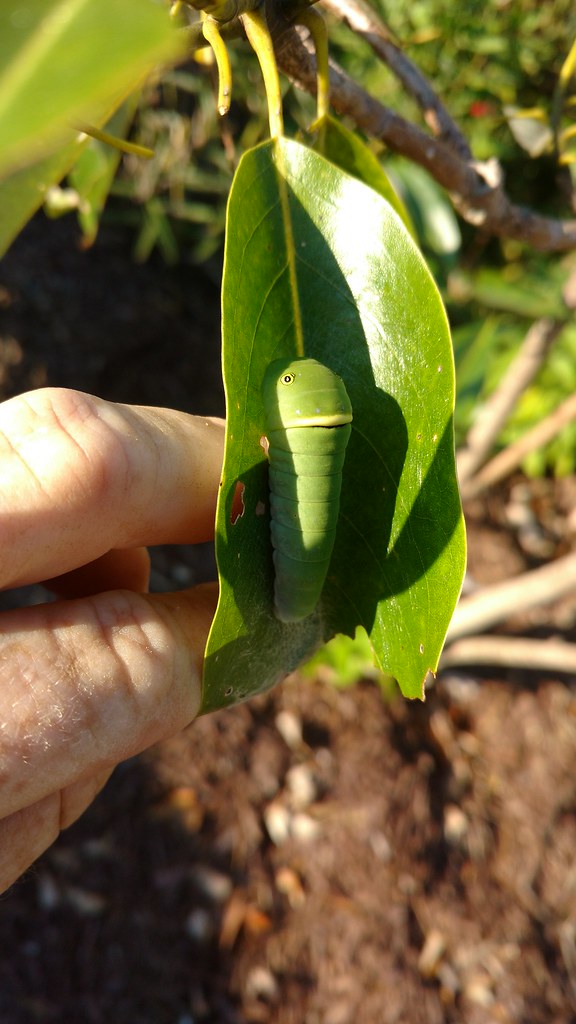 I came back from a mini trip and the first thing I noticed was my sweet bay magnolia; which is in a very prominent position out front; was nearly defoliated! Sweet bays are semi evergreen here in most of Tennessee, and I had been nurturing this one for over a year. It is doing very well now so all of the leaves being gone-eaten-was quite noticeable to me. I looked closely and I discovered the culprits! These two caterpillars are some type of swallowtail. I think perhaps Eastern Tiger Swallowtail but I am not sure. These are fairly common caterpillars though I have never seen them before. We do have tons of swallowtail butterflies here though and I love them. These swallowtail cats have what appear to be false eyes-can you see the one eye above? The false eyes help to scare off predators.
I came back from a mini trip and the first thing I noticed was my sweet bay magnolia; which is in a very prominent position out front; was nearly defoliated! Sweet bays are semi evergreen here in most of Tennessee, and I had been nurturing this one for over a year. It is doing very well now so all of the leaves being gone-eaten-was quite noticeable to me. I looked closely and I discovered the culprits! These two caterpillars are some type of swallowtail. I think perhaps Eastern Tiger Swallowtail but I am not sure. These are fairly common caterpillars though I have never seen them before. We do have tons of swallowtail butterflies here though and I love them. These swallowtail cats have what appear to be false eyes-can you see the one eye above? The false eyes help to scare off predators.
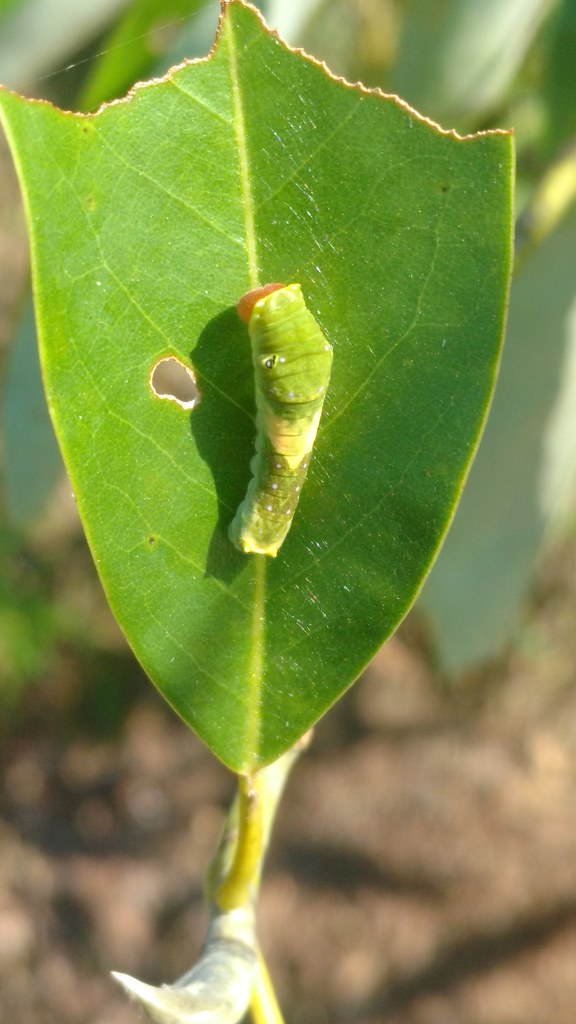 This is the same type of caterpillar but an earlier instar. It is disguised to look like bird poop with the cream colored blotch on its back. How cool is that?
This is the same type of caterpillar but an earlier instar. It is disguised to look like bird poop with the cream colored blotch on its back. How cool is that?
Many folks bring caterpillars into enclosures to watch the process of them turning into a chrysalis and then hatching out as a butterfly. I have done this in the past but did not bring any of these caterpillars in to do so this year. I am really not sure how to do it completely properly and prefer to let nature do the work here....
in the garden.....enjoying the baby butterflies.
Words and Photos Property of In the Garden Blog Team, In the Garden
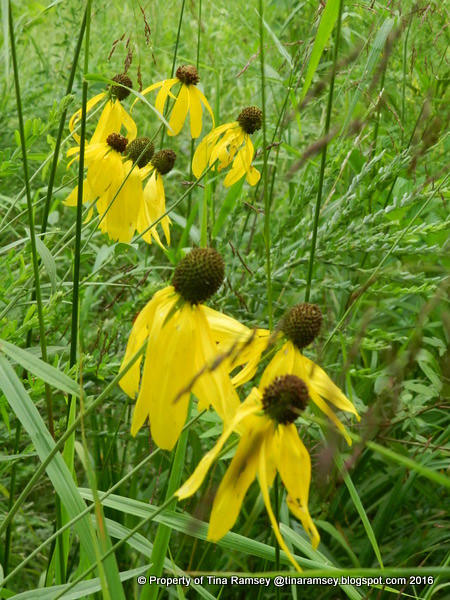 Let's talk about Wildflower Hill today. You all may remember we purchased our property three and one half years ago. At that time we had to clear a lot of trees and scrub growth. After everything was cleared we wound up with predominately broomsedge grass on the Wildflower Hill portion of our property. While broomsedge is not bad for wildlife I wanted forbs in order to feed the pollinators and wildlife such as birds and deer.
My solution for adding forbs was to wintersow a good amount of native wildflower seed purchased from Roundstone Seed in Kentucky in February 2014. This was after speaking to the Tennessee biologists about the area of my land I needed help developing. I really wished for help doing a prescribed burn but help was not forthcoming so Mr. Fix-it and I went it on our own by wintersowing. All of my research told me it would take a few years for the wildflowers to even show up let alone spread and take hold after seeding. Enter summer 2016 and we are now seeing some results from our labors. The above gray headed coneflowers are definitely one of the seeded forbs I added to the area. This is the first year I have seen it and I am very excited!
Let's talk about Wildflower Hill today. You all may remember we purchased our property three and one half years ago. At that time we had to clear a lot of trees and scrub growth. After everything was cleared we wound up with predominately broomsedge grass on the Wildflower Hill portion of our property. While broomsedge is not bad for wildlife I wanted forbs in order to feed the pollinators and wildlife such as birds and deer.
My solution for adding forbs was to wintersow a good amount of native wildflower seed purchased from Roundstone Seed in Kentucky in February 2014. This was after speaking to the Tennessee biologists about the area of my land I needed help developing. I really wished for help doing a prescribed burn but help was not forthcoming so Mr. Fix-it and I went it on our own by wintersowing. All of my research told me it would take a few years for the wildflowers to even show up let alone spread and take hold after seeding. Enter summer 2016 and we are now seeing some results from our labors. The above gray headed coneflowers are definitely one of the seeded forbs I added to the area. This is the first year I have seen it and I am very excited!
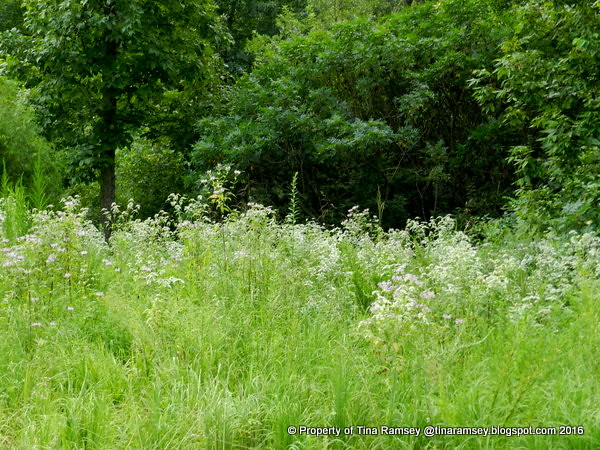 Here is a long look at one part of the approximately two acre area of Wildflower Hill. It looks like a jumble of weeds--and some might consider it so but not me! It is pure beauty.
Here is a long look at one part of the approximately two acre area of Wildflower Hill. It looks like a jumble of weeds--and some might consider it so but not me! It is pure beauty.
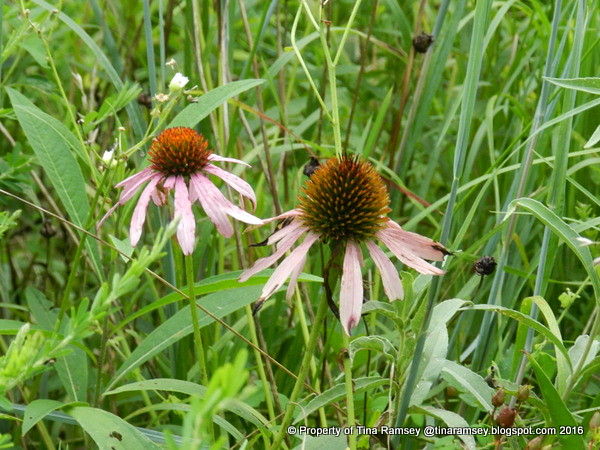 Coneflowers have been growing in the area for two summers now. They are beginning to seed about a bit. I am ever so happy to see happy wildflowers!
Coneflowers have been growing in the area for two summers now. They are beginning to seed about a bit. I am ever so happy to see happy wildflowers!
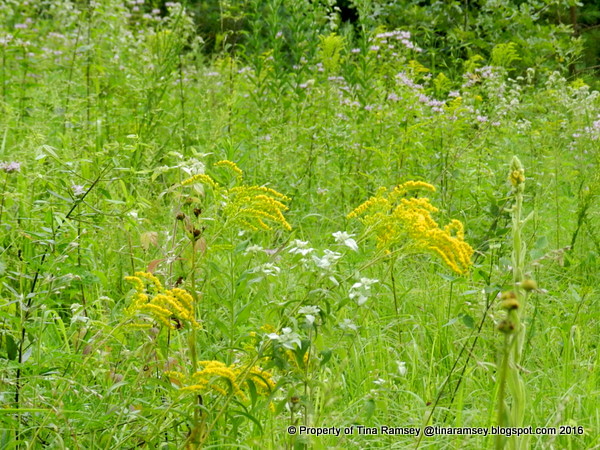 Goldenrod, mountain mint, and wild beebalm already had seeds laying dormant in the soil. While some of these wildflowers may be from my seeding the wildflower seed I think the majority of these seeds just needed to be exposed to the sun in order to sprout and grow. I say this because the goldenrod is a fairly common roadside weed that grows abundantely just about everywhere. The mountain mint and bee balm are thick as thieves in one particular spot of the Wildflower Hill and that is not a spot where I sowed my seeds. Those two wildflowers are spreading out and attract predominantly swallowtail butterflies. On any sunny day I can ride down the hill and marvel in the hundreds, if not thousands, of butterflies partaking of these plants. It is almost really surreal! Imagine everything in slow motion without hardly a sound around and you see black butterflies gently swaying back and forth between flowers. Amazing, simply amazing.
Goldenrod, mountain mint, and wild beebalm already had seeds laying dormant in the soil. While some of these wildflowers may be from my seeding the wildflower seed I think the majority of these seeds just needed to be exposed to the sun in order to sprout and grow. I say this because the goldenrod is a fairly common roadside weed that grows abundantely just about everywhere. The mountain mint and bee balm are thick as thieves in one particular spot of the Wildflower Hill and that is not a spot where I sowed my seeds. Those two wildflowers are spreading out and attract predominantly swallowtail butterflies. On any sunny day I can ride down the hill and marvel in the hundreds, if not thousands, of butterflies partaking of these plants. It is almost really surreal! Imagine everything in slow motion without hardly a sound around and you see black butterflies gently swaying back and forth between flowers. Amazing, simply amazing.
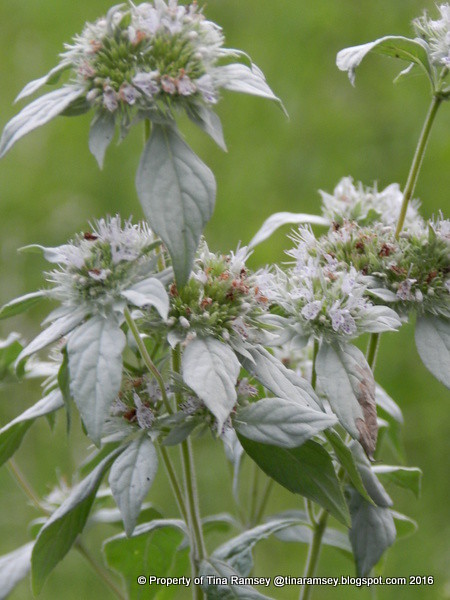 A close up of the mountain mint.
A close up of the mountain mint.
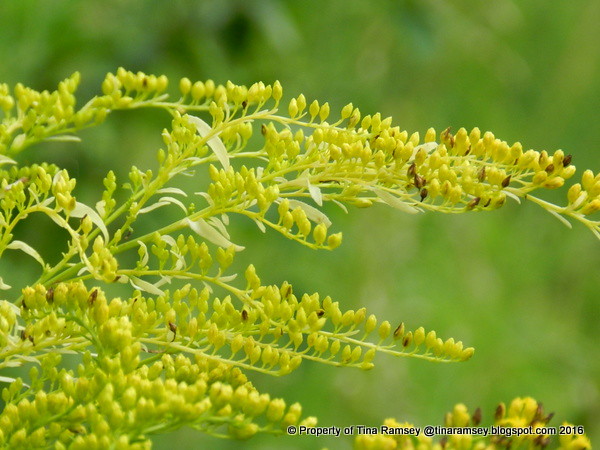 A close up of the goldenrod. This is a wonderful wildflower and I think it will help to sustain my bees over the winter. I never find any honeybees on these flowers but I can smell the distinctive smell of goldenrod nectar as they bring it to the hive. Hopefully they will make lots of honey to sustain them over the winter.
A close up of the goldenrod. This is a wonderful wildflower and I think it will help to sustain my bees over the winter. I never find any honeybees on these flowers but I can smell the distinctive smell of goldenrod nectar as they bring it to the hive. Hopefully they will make lots of honey to sustain them over the winter.
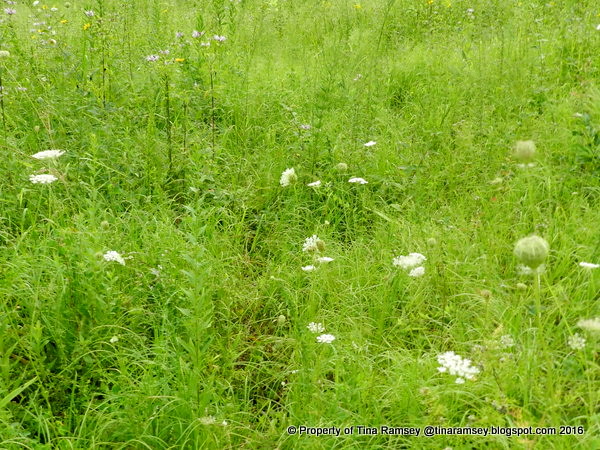 Queen Anne's lace is a non-native wildflower that has naturalized here in America. I like it even though it is not native. I always finds lots of bugs partaking of its goodness.
Queen Anne's lace is a non-native wildflower that has naturalized here in America. I like it even though it is not native. I always finds lots of bugs partaking of its goodness.
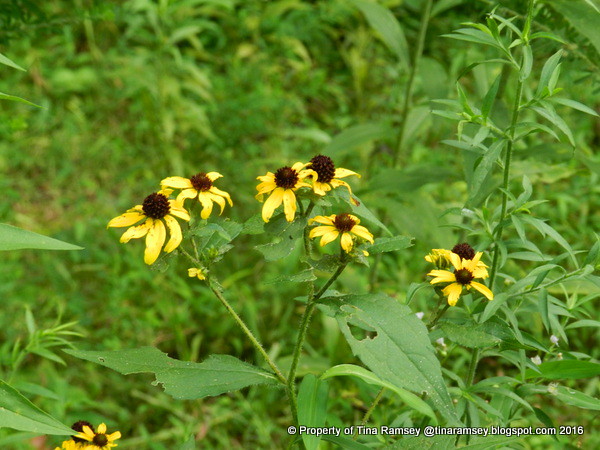 Tall coreopsis (Coreopsis tripteris) grows predominately at the bottom of Wildflower Hill. Two years ago it was a solid mass of flowers. Last year and this year it has not come back as strong and robust as that first year.
Tall coreopsis (Coreopsis tripteris) grows predominately at the bottom of Wildflower Hill. Two years ago it was a solid mass of flowers. Last year and this year it has not come back as strong and robust as that first year.
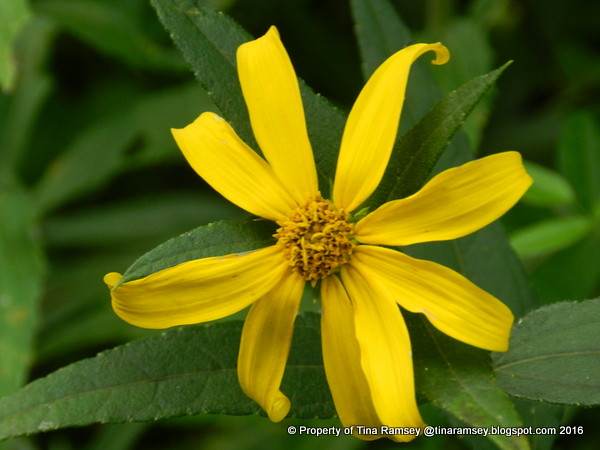 Greater tickseed is a pretty little ray of sunshine.
Greater tickseed is a pretty little ray of sunshine.
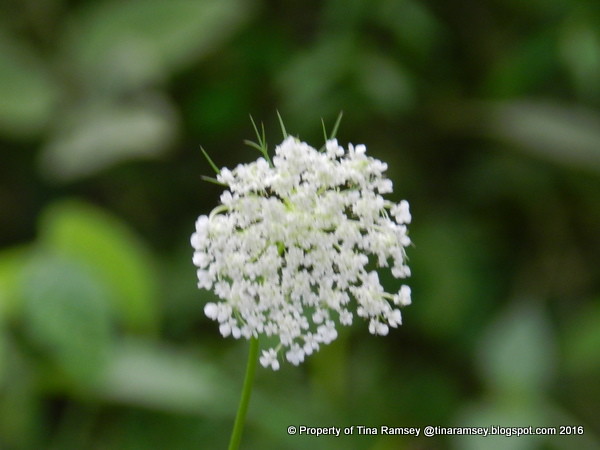 Queen Anne's lace.
Queen Anne's lace.
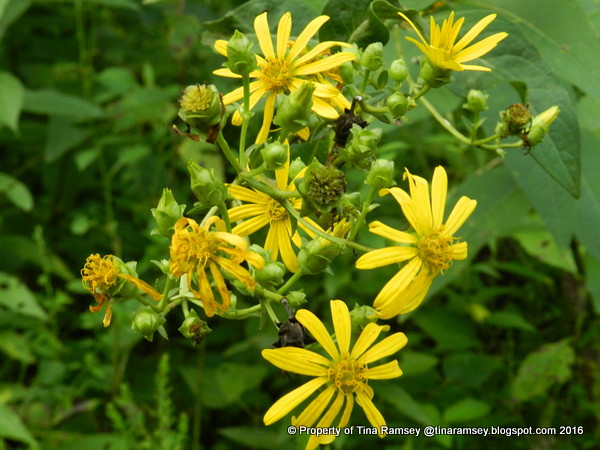 I am not sure what type of wildflower this one is. It may be more Coreopsis major or a type of cup plant or something else. I need to do more research on this one.
I am not sure what type of wildflower this one is. It may be more Coreopsis major or a type of cup plant or something else. I need to do more research on this one.
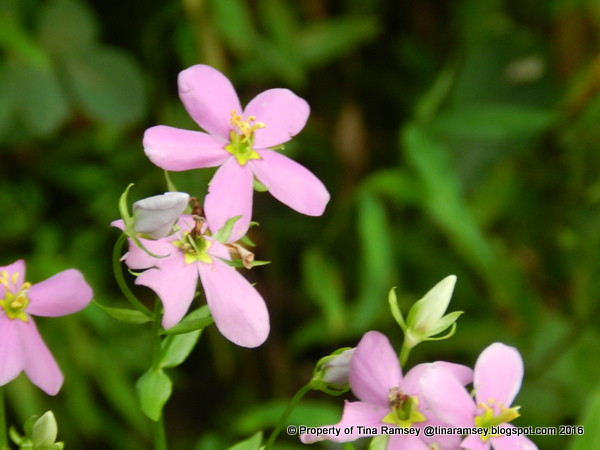 Rose pink (Sabatia angularis) is a biennial that showed itself big time two years ago. This year it is back but not in such great numbers as it was two years ago. This is not an issue limited only to Wildflower Hill because I noticed that along the roadsides it has not shown up as much as two years ago either.
Rose pink (Sabatia angularis) is a biennial that showed itself big time two years ago. This year it is back but not in such great numbers as it was two years ago. This is not an issue limited only to Wildflower Hill because I noticed that along the roadsides it has not shown up as much as two years ago either.
Also flowering but not pictured are: bee balm, verbascum, butterflyweed, asters, and ironweed....
in the garden....
Words and Photos Property of In the Garden Blog Team, In the Garden










































